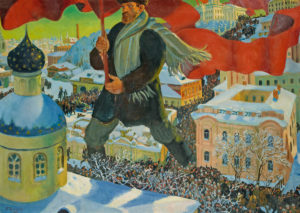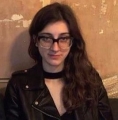You have no items in your cart. Want to get some nice things?
Go shopping
To hear Jonathan Jones tell it, the Royal Academy has gone full Proletkult and Pravda with Revolution, their ambitious exhibition of 15 years of Russian art, October Revolution to Stalinism, man-machines and suprematist squares to blockish peasant forearms and fields of wheat. It’ll be catnip to Wolfie Smiths and other bedside revolutionaries, who will surely be eager to spend £16 to gawk at an embalmed Bolshevik past, but what about all the dead kulaks behind the red wedges and ushankas, Jones worries.
Jones said he won’t attend but if he does he’ll likely feel his outrage vindicated by the first gallery. There the walls are painted a blazing communist red, and Lenin, alive and dead, looms like an icon from every corner. A reproduction banner rallies for “Вся власть Советам” (“All Power to the Soviets”), and there’s enough tat–china plates slathered with hammers and sickles and kerchiefs with a pantheon of communist greats, and Trotsky’s face sheared out–to satisfy even the greatest enthusiasts of Soviet kitsch and communist in-fighting. But if at first blush Revolution does indulge Bolshevik agitprop, it’s down to the sheer iconographic verve and ambition of that propaganda. These were art and objects to inculcate a new consciousness and build a new world. Revolution pays them respect but, with a tilt toward the sombre and a probe at the limits and brutality of utopia, it’s for more than just fetishists and fellow travellers.
Provided you’re unmoved by the painted parables of strapping peasants and eagle-eyed leaders that occupy the latter half of the timeline and the exhibit, the draw here is the iconoclastic experimentation of the early Bolshevik years. There’s a staggering reconstruction of a 1932 hanging of Malevich’s suprematist paintings, his dilations of his earlier cubo-futurist works into sheer geometric abstraction. Untethered from the visual world, these paintings, including Red Square and a later version of the 1915’s shattering Black Square, locate a kernel of “pure feeling” in colour and form. Beneath these cracklingly reductive canvases Malevich arranged on an altar-like table plaster maquettes of “architectons”, here in originals and reproductions. These never-realized buildings were supposed to radically reconfigure everyday life and, as suggested by the model of a Soviet man perched atop of the tallest, set against the empyrean geometry of a Suprematist canvas, imbue it with a cosmic significance. Malevich named each of these architectons with Greek letters, as astronomers tag constellations. Even artists working in more established modes, like Impressionist Konstantin Yuon, felt this cosmic momentum of revolution. His 1921 paintings New Planet depicts, in shards of unearthly light, the cataclysmic destruction of an old world and birth of a new–and the awe-struck reactions of puny humans swept up in that planetary force.
The Constructivists valued materiality and function over aesthetics in a way that jarred with Malevich’s mystic, anti-materialist creed, but they shared his conviction in the capacity of art to transform byt (everyday life) and transcend the existing world. Here, they share gallery space: bristling agitprop posters and photomontages by Mayakovsky and Rodchenko, harnessing a graphic geometry to promote socialist ideals to the masses and later, in the NEP years, to sell them beer and bread; and glass paintings by Sofia Dymshits-Tolstaya, with revolutionary slogans and workers’ tools fractured into cubist shards. Meanwhile, architects attempted to engineer new ways of life through the design of buildings and cities: The Narkomfin Building, in Moscow, designed by Moisei Ginzburg, was a “social condenser”, with communal kitchen, dining, and laundry facilities intended to dissolve the bourgeois construct of family into socialist collectivism. A rendering of El Lissitzky’s design for an apartment in the building dominates a room in Burlington House: it’s geometric and spare, like quarters for a cosmonaut, for the New Soviet man catapulted into a brave, and often terrifying, new world.
At times this attempt to bridge the quotidian and the cosmic through art and object ends in laughable quixotism: in, for example, food rations cards for the lean years of the Civil War, decorated in a Suprematist style by Malevich protégé Boris Tseitlin. Sometimes it’s merely poignant. A reconstruction of Tatlin’s “flying machines” spins eerily in the central gallery here, casting ghostly shadows. Modelled on the wings of birds and insects, these “Letatlin” were supposed to be “flying bicycles” for workers, but, like Da Vinci’s, never managed flight. Like Tatlin’s Tower, a model of which twisted in the courtyard here five years ago, it’s hard not to reduce this glider to metaphor: for the hubris of revolutionary schemes and the stubborn flightlessness of the Soviet utopia.
Constructivist artists like Lyubov Popova rejected eventually rejected painting entirely as individualist and inaccessible to the masses and embraced design–in posters, fabric, clothes–and the materiality of the object. And director Dziga Vertov postioned his films, most famously Man with a Movie Camera, purporting to capture “life unawares”, as a rebuke of the “bourgeois” “opiate” of fiction. But categories of “bourgeois” and “proletariat” were slippery. Their experimentations–and those of others–would eventually be rejected as elitist affections themselves, as Stalinism enforced a dogma of narrative, symbolism, aesthetic beauty, and popular appeal in art. Constructivism was, in the words, of the VOPRA, a union of “proletarian” architects, a “collision between psycho-ideology and the habits of the petit-bourgeois intelligentsia.”
The difference between early Bolshevik experimentation and socialist realism is not only in aesthetics, the parsecs between the shocking minimalism and lurid oil-painted triumphalism, but also in their conception of Soviet society, the future, and the historical project of Marxism. Both strove to indoctrinate and believed art could guide social development. But while the constructivists and others projected and strove for a utopian future, and even designed its living spaces and crockery, socialist realism presented, with verisimilitude, monumentalism and heavy-handed symbolism, an idyll already achieved. Stalin declared in 1936 in a report delivered to the Extraordinary Eight Congress of the Soviets that the first phase of communism had been achieved. It didn’t have flying bicycles or strange constructivist clothing, but all its white-scarfed peasants were smiling and its leaders purposefully striding.
Revolution borrows its shape from a 1932 retrospective of Fifteen Years of Artists of the Russian Soviet Republic, curated by Nikolai Punin and staged at the State Russian Museum in Leningrad. But when Fifteen Years was restaged in the State Historical Museum in Moscow’s Red Square in 1933, it was without its second gallery of constructivist and abstract art.
But the schism wasn’t as neat and sudden as this story and Revolution present it. Lenin had been a staunch cultural traditionalist and always sceptical of the excesses of the avant-garde, and debates about how proletarian culture would arise, what shape it would take, and who could practice it would had simmered since 1917, and artists had already been nudged away abstraction by the late 1920s. Before he was banned from producing or exhibiting art in the 1930s, Malevich, for example, was producing representational canvases like Woman with a Rake and Head of a Peasant that gesture toward the accepted subjects of socialist realism but employ suprematist geometry–a featureless face bifurcated in black and white, for example–to decry the horrors of forced collectivization. And the socialist realist paintings and photography featured at the conclusion of the exhibit–the bulging muscles of sportsmen and the empty, anonymous faces of young Pioneers–under the headline “Stalin’s Utopia,” are little different than those reifying the Soviet shock worker at the start of the exhibit and the timeline. Some of the artists are even the same: Rodchenko, Arkady Shaike–those who could adapt. Others, including Nikolai Punin, curator of the Fifteen Years exhibit, fell to Stalin’s scythe. Punin’s face flashes in a small black theatre at the conclusion of the exhibit, with those of many others–famous and ordinary, writers and economists and collective farm workers–who lost their lives and freedom to Stalin’s whirlwind.
In retrospect, even the first brash red room that would so alarm Jonathan Jones is stalked by death, censorship, Stalin. After walls of Leninist iconography, we encounter plans for and a model of Lenin’s mausoleum and a controversial portrait, by Kuzma Petrov-Vodkin, of the leader in a red-lined coffin–long hidden for foiling the myth of Lenin’s immortality (in a way the increasingly ragged state of his embalmed body apparently didn’t). Icon-painter Kliment Redko’s “Uprising” gathers disciples–and potential successors–including Trotsky and Stalin, around a hieratically posed Lenin, but encases them in a diamond set in a burning cityscape: producing utopia from the carbon of everyday life will involve colossal and unforgiving force. It’s that force that expunges Trotsky from history and handkerchiefs, and then ice-picks him; that reacts against avant-garde experimentation in favour of the sun-bathed triumphalism and easy symbolism of socialist realism; that buries any art that doesn’t reify its leaders and uphold its myths. Stalin lurks in a corner of this first room: canny and towering in a 1927 official portrait by Isaak Brodsky, and in Georgy Rublev painting, reclining with a dog and a copy of Pravda, depicted with a Chagall-esque folkloric unworldliness–and with notably tiny feet. Brodsky’s work became a prototype for socialist realism and he was later tasked with producing romanticized renderings of key events in the October Revolution and Civil War. Stalin apparently hated Rublev’s depiction, and it wasn’t exhibited until decades after his death, and only after Rublev himself had died. To outlive Stalin, he was one of the luckier ones.
There’s celebration here: of the audacity of trying to transform the world, down to its kitchenware, of the staggering inventiveness revolution unleashed. But there’s also extraordinary brutality, in the empty faces of Malevich’s peasants, in graphic posters showing meagre food allowances during the Civil War, in art that expresses both great hope and great terror for the impending socialist future, in gimlet-eyed portraits of Stalin and the final theatre in a black box. Don’t be fooled by the red banners and the iconic agitprop: this is more of an ossuary for failed utopias than a May Day parade and the lingering taste is regret.
Revolution: Russian Art 1917-1932 continues at the Royal Academy until April 17 2017. Tickets are £16 (£12 concessions).





